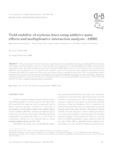Por favor, use este identificador para citar o enlazar este ítem:
http://www.alice.cnptia.embrapa.br/alice/handle/doc/507367Registro completo de metadatos
| Campo DC | Valor | Lengua/Idioma |
|---|---|---|
| dc.contributor.author | ROCHA, M. de M. | pt_BR |
| dc.contributor.author | VELLO, N. A. | pt_BR |
| dc.contributor.author | LOPES, A. C. de A. | pt_BR |
| dc.contributor.author | MAIA, M. C. C. | pt_BR |
| dc.date.accessioned | 2011-04-10T11:11:11Z | pt_BR |
| dc.date.available | 2011-04-10T11:11:11Z | pt_BR |
| dc.date.created | 2007-10-31 | pt_BR |
| dc.date.issued | 2004 | pt_BR |
| dc.identifier.citation | Crop Breeding and Applied Biotecchnology, Viçosa, MG, v. 4, p. 391-398, 2004. | pt_BR |
| dc.identifier.issn | ISSN 1518-7853 (impresso) / 1984-7033 (online) | pt_BR |
| dc.identifier.uri | http://www.alice.cnptia.embrapa.br/alice/handle/doc/507367 | pt_BR |
| dc.description | The grain yield of 27 soybean lines was evaluated at three locations (Anhembi, Areão and Esalq) in Piracicaba, State of São Paulo, Brazil, during four crop years to study the effect of environment (E) on the adaptability and stability of the lines (G) using additive main effects and multiplicative interaction analysis (AMMI). Effects of the G, E, and GE interaction were found to be significant and accounted for 51, 12, and 36% of the variation, respectively. The first and only significant interaction principal component axis (IPCA1) accounted for 26% of the sum of squares due to original GE interaction. This concentrated the largest proportion of the pattern of GE interaction. Environments associated with Anhembi and Esalq proved more favorable, while Areão contributed negatively to the grain yield. However, Anhembi and Areão were more predictable for the crop years. USP 93-5082 and USP 93-5243 lines combined high adaptability and stability. | pt_BR |
| dc.language.iso | eng | eng |
| dc.rights | openAccess | eng |
| dc.subject | Interação genótipo-ambiente | pt_BR |
| dc.subject | Adaptabilidade | pt_BR |
| dc.subject | Adaptability | pt_BR |
| dc.subject | Estabilidade | pt_BR |
| dc.subject | Estability | pt_BR |
| dc.subject | Modelo AMMI | pt_BR |
| dc.subject | AMMI model | pt_BR |
| dc.subject | Rendimiento de los cultivos | pt_BR |
| dc.subject | Interacción genotipo-ambiente | pt_BR |
| dc.subject | Semillas de soja | pt_BR |
| dc.title | Yield stability of soybean lines using additive main effects and multiplicative interaction analysis - AMMI. | pt_BR |
| dc.type | Artigo de periódico | pt_BR |
| dc.date.updated | 2019-01-08T11:11:11Z | pt_BR |
| dc.subject.thesagro | Soja | pt_BR |
| dc.subject.thesagro | Glycine max | pt_BR |
| dc.subject.thesagro | Rendimento | pt_BR |
| dc.subject.nalthesaurus | Soybeans | pt_BR |
| dc.subject.nalthesaurus | Genotype-environment interaction | pt_BR |
| dc.subject.nalthesaurus | Crop yield | pt_BR |
| riaa.ainfo.id | 507367 | pt_BR |
| riaa.ainfo.lastupdate | 2019-01-08 -02:00:00 | pt_BR |
| dc.identifier.doi | 10.12702/1984-7033.v04n04a03 | pt_BR |
| dc.contributor.institution | MAURISRAEL DE MOURA ROCHA, CPAMN | pt_BR |
| dc.contributor.institution | NATAL ANTÔNIO VELLO, Escola Superior de Agricultura "Luiz de Queiroz" (ESALQ)/ USP | eng |
| dc.contributor.institution | ANGELA CELIS DE ALMEIDA LOPES, Universidade Federal do Piauí (UFPI) | eng |
| dc.contributor.institution | MARIA CLIDEANA CABRAL MAIA, CPAF-AC. | eng |
| Aparece en las colecciones: | Artigo em periódico indexado (CPAF-AC)  | |
Ficheros en este ítem:
| Fichero | Descripción | Tamaño | Formato | |
|---|---|---|---|---|
| 16437.pdf | 102,96 kB | Adobe PDF |  Visualizar/Abrir |









